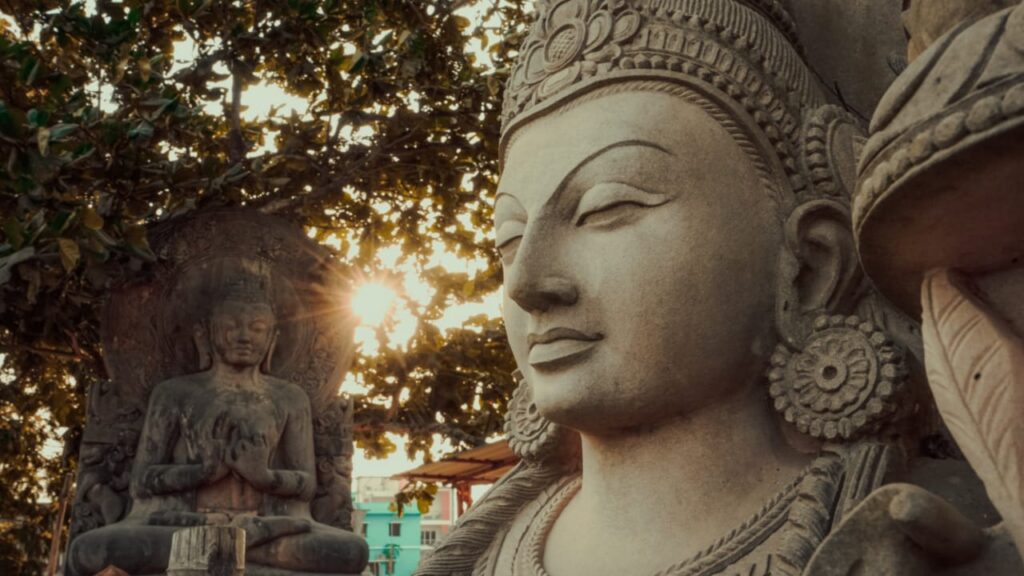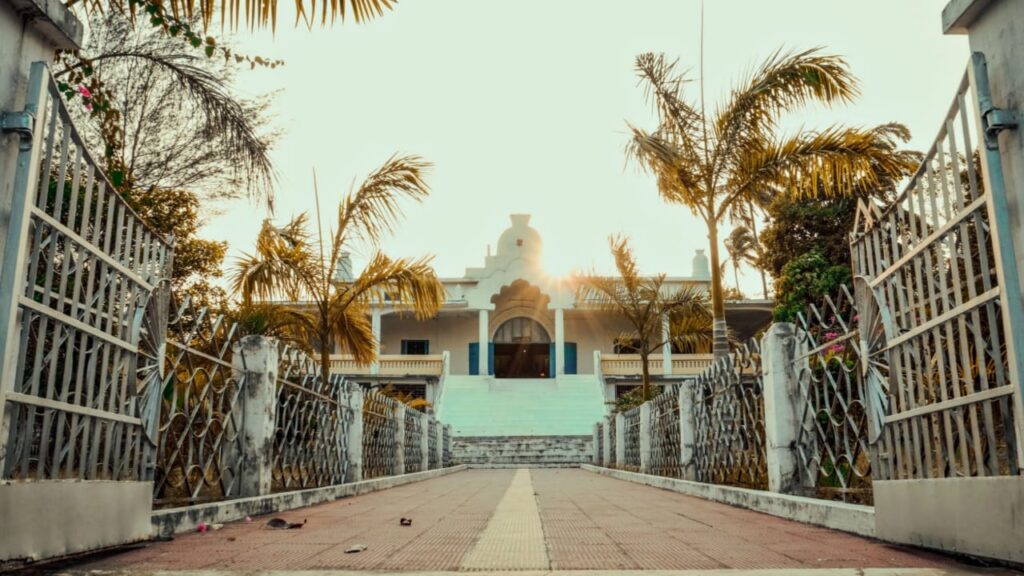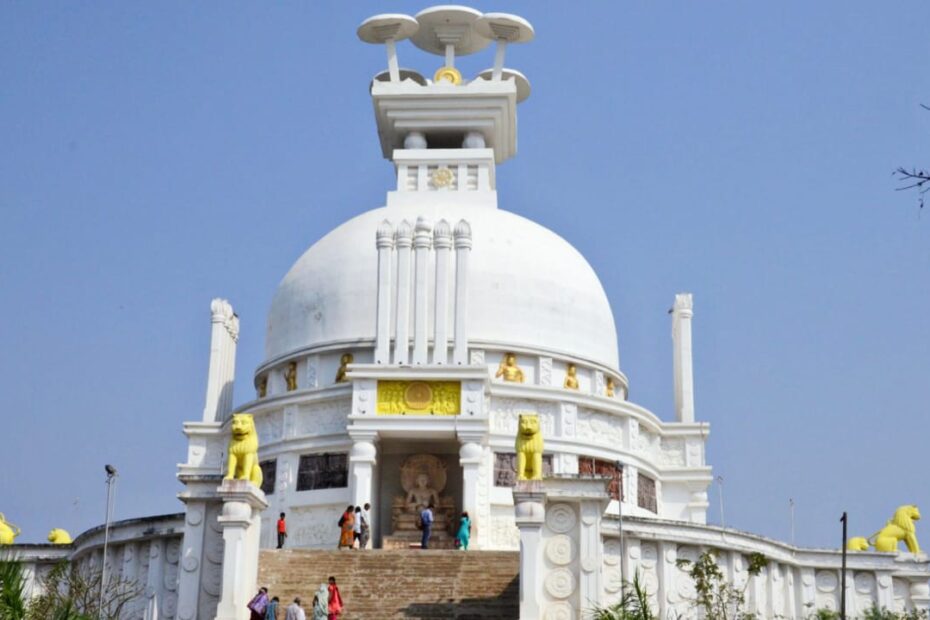Dhauli Giri Hills is located on the bank of the Daya River.
It is approximately 8 kilometers from Bhubaneswar, Odisha; however, it is considered a part of the city and one of its major tourist attractions.
These hills, surrounded by plains, forests, and the Daya River, house the beautiful monument of Dhauli Shanti Stupa.
ADVERTISEMENT
This eye-catching white dome-shaped stupa is a clear symbol of peace and spirituality in the city.
In this article, you will get to know the following points about Dhauli Shanti Stupa,
Let’s see each of these points in detail.
How to reach Dhauli Shanti Stupa
Bhubaneswar is well-connected through regular flights and trains to all major cities in India.
Local buses, private cabs, and auto rickshaws frequently run between the airport, Railway Station, and Dhauli Giri Road.
Dhauli Giri Hills is 9.9 kilometers from Biju Patnaik International Airport, and it takes about 25 minutes to get there.
The Bhubaneswar Railway Station, on the other hand, is approximately 9.7 kilometers from the Dhauli Giri hills, and it takes nearly 24 minutes to reach.
If you want to travel from Puri, you can include this place in your sightseeing tour. It is often listed as one of the famous places near Puri.
The architecture of Dhauli Shanti Stupa
The stupa’s overall structure is shaped like a dome. Over the stone panels, you can see Buddha’s footprints as well as the Bodhi tree (a large and sacred fig tree).
You can also see an image of Ashoka holding his sword of war in front of Lord Buddha with an elephant and horseback procession, and various Buddhist anthems implying that he had given up the idea of war entirely.
ADVERTISEMENT
There are some amazing stone carvings of Lord Buddha in different postures along with a relaxing posture.
Dharma chakra was used as decoration in Buddhist temples, statues, and inscriptions.
History of Dhauli Shanti Stupa

It was during 272 B.C. when the great king Asoka of the Mauryan Empire was looking at the battlefield horrified after his victory. The Kalinga war field which is now Dhauli was flooded with blood and bodies of people. After realizing the seriousness and the tragic situation, the legendary ruler Ashoka had a sincere transformation within himself.
He then directed his energy towards spirituality accepting Buddhism and everything related to it. also, he reflected his spirit towards the good. Ashoka went on spreading Buddhism all throughout the state of Odisha, then in the entire country of India, and ahead of that.
Still today we can see an elephant carving which marks the exact point of his conversion. It also symbolizes the start of Buddhism. The Dhauli Shanti Stupa is an extremely important feature of Dhauli. It was constructed in 1972 to honor the king’s transformation from a cruel fighter to a peace-loving spiritual man.
The dome-shaped structure stands proudly as a sign of peace and positivity. It has buddhas life stories, and statues as well as his teachings. Dhauli Shanti Stupa is much more than just a place to visit.
Things to do in Dhauli Shanti Stupa
There are a lot of things to do in Peace Pagoda,
- Witness the beautiful dazzling monument of the stupa.
- Meditate in the peaceful atmosphere of the stupa.
- Explore the different historical artifacts and relics to know more about Buddhism.
- Dive into the historical past of King Ashoka.
- Visit the monastery and soak in the spiritual ambiance of the place.
- Experience the panoramic view of Bhubaneshwar and the picturesque Daya River.
ADVERTISEMENT
Kalinga Dhauli Mahotsav
The main festival at Dhauli Giri Hills is the Kalinga Dhauli Mahotsav. It takes place every year in February.
The Odisha Tourism Department organizes this three-day festival. The festival is well-known for its classical dance, classical music, and martial art dance performances.
This event features renowned dancers, musicians, and over 500 performance artists from across the country.
Other attractions near Dhauli Shanti Stupa

A monastery known as the Saddharma Vihar Monastery is located near this stupa and is frequently visited by Buddhist devotees.
A short distance from the Shanti Stupa is the Dhavaleshwar temple, which was renovated in 1972 and is popular with both Hindu and Buddhist devotees.
These are some of the things you should know about the Dhauli Shanti Stupa.
So if you are planning to visit Bhubaneshwar or Puri, plan a trip to this place, especially during this special festival!
Other places to visit in Odisha
- Similipal National Park (Odisha) – Resorts, Attractions

- 6 Famous Sea Beaches You Must Visit In Odisha (India)

- 5 Best Places And Popular Attractions To Visit In Puri (Odisha)

- Golden Beach, Puri (Odisha) – Timings, Entry Fee, Things To Do

- Bangriposi (Odisha) – How To Reach, Resorts, Attractions

- Talsari Sea Beach (Odisha) – 6 Points To Know Before You Visit

Disclaimer: Some of the links provided in the article may contain affiliate links. This means when you book or buy something using these links, you help support the website at no extra cost.

